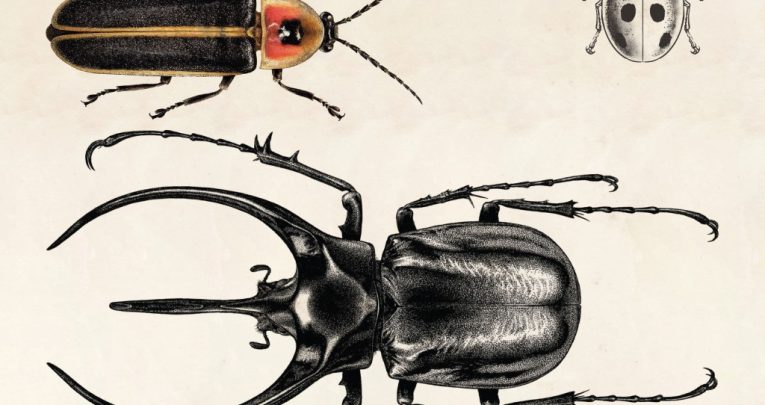KS2 Book Topic – Creative Classroom Activities with MG Leonard’s The Beetle Collector’s Handbook

Get your pupils going bonkers for bugs with author MG Leonard’s creative classroom activities…

- by MG Leonard

When I go into schools and talk to the children, I ask everyone to put their hand up if they are afraid of any sort of creepy-crawly.
Usually, 50 per cent of the room raises an arm – including teachers. I can relate. I spent 30 years of my life phobic about bugs.
But, in our planet’s ecosystem, invertebrate life is essential for keeping the machine working.
Put simply, without them, we die.
So why don’t we like and appreciate mini-beasts? Why do we perpetuate this unhelpful myth that they are frightening?
It isn’t a universally human thing. In Eastern cultures they celebrate insects. In Japan children have pet beetles like we have pet hamsters.
Maybe it is because in the West we characterise bugs as horrid, scary, evil and dirty – in our language, our films, our TV programmes and our stories.
That’s why I wrote my insect-filled trilogy, where beetles are the good guys, and why I followed it with a non-fiction guide to the most bonkers and brilliant beetles on the planet.
I want beetles to capture children’s imagination in a positive way, to awaken their curiosity and perhaps help them on their first steps to having a relationship with the natural world.
Beetles make for a fascinating, creative and rewarding topic for classroom activities; I’ve put together a raft of activities that might make up a scheme of work, or a small project – why not try some of these in your summer term?
If you do, be sure to share the students’ work with me on social media. I will reply and celebrate any and all of it!
Introducing the handbook
The Beetle Collector’s Handbook is a non-fiction book about beetles, which complements my fictional adventure trilogy: Beetle Boy, Beetle Queen and Battle of the Beetles.
It is humorously narrated by a fictional entomologist, Dr Montgomery George Leonard – see what I did there? The Beetle Collector’s Handbook sets out its manifesto in the introduction – to inspire a new generation of bug hunters.
The book is divided into three parts.
Preparing for an Expedition introduces the science of entomology, explains what a beetle is, explains taxonomy, suggests what to take on a bug hunt and where to find beetles.
Next, The Beetles features information about more than fifty species, accompanied by beautiful and biologically accurate illustrations by Carim Nahaboo.
Finally, The Entomologist’s Epilogue contains a strong message about conservation and protecting the habitats of insects, as well as the stories of two entomologists working today.
It also contains an entomologist’s dictionary – a glossary of useful insect words along with simple definitions.
The Beetle Collector’s Handbook is annotated by the fictional characters from the Beetle Boy trilogy; it aims to serve as a crossover book for those who enjoy non-fiction but resist fiction, and vice versa, and works best in the classroom when twinned with Beetle Boy.
Why not try some of the following activities with your pupils?
1 | The life cycle of a beetle
Read pages 14–15 of The Beetle Collector’s Handbook with the class and look at the illustration Fig 2 ‘The Life Cycle of the Stag Beetle’.
Ask pupils to draw their own picture of the four different stages of a beetle’s life.
Introduce them to the word ‘metamorphosis’, meaning the transformation or changing of an insect’s body.
Consider what they know about the life cycle of a butterfly. Compare a butterfly’s life cycle to that of a beetle; The Very Hungry Caterpillar is a good book for this exercise.
2 | Beetle bodies
On page 13 of The Beetle Collector’s Handbook there is a labelled diagram of a stag beetle (Fig 1).
Hand out an unlabelled diagram of a beetle (these can be found freely on the internet) and ask the class to attach the right words to the right parts of their beetle’s body.
The required vocabulary, with easy to read definitions, can be found in the entomologist’s dictionary on pages 154-157.
3 | Make your own beetle
Using recycled things brought in from home, ask the children to create and name their own beetle using The Beetle Collector’s Handbook for inspiration. Then ask them to talk or write about their beetle’s habitat, life-cycle, food… and any super skills it might have.
4 | Create a field journal
A naturalist should always have a field journal in which they can record their findings when on adventures.
On page 27 of The Beetle Collector’s Handbook there is an example page; get the children to create their own, then send them out into the playground to find an insect and enter it into their journal (they may need to look up their bug in a book or on the internet to find out its scientific name).
5 | Pack an entomologist’s backpack
Read pages 19-21 of The Beetle Collector’s Handbook with your class, then encourage them to write a list of what they think they would put in their own entomologist’s backpack.
6 | Build a bug hotel
You may want to build a large bug hotel in your playground to encourage beetles to share the school; you can find step by step instructions on page 25 of The Beetle Collector’s Handbook.
If there isn’t space, each child could build a small, hanging bug hotel for their own garden, or windowsill – watch my Blue Peter make video here.
All you need are a plastic bottle, sticks and leaves, scissors and string.
7 | Careers in entomology
On pages 148-153 of The Beetle Collector’s Handbook you will find two well-known entomologists – Dr Sarah Beynon of the Bug Farm and Max Barclay, head coleopterist at the Natural History Museum – talking about their lives as entomologists and their passion for beetles.
Read these pages with the class, and share these YouTube videos: Sarah Beynon and Max Barclay.
Using this pair as case studies, ask the class to write a story about the adventures of a young entomologist.
From fact to fiction
Beetle Boy (suitable for years 4-7) describes the adventures of 13-year-old Darkus Cuttle, as he and a giant rhinoceros beetle called Baxter set out to discover what has happened to his father, who has mysteriously disappeared from inside a locked room at the Natural History Museum.
The story is darkly humorous, and has been edited by an entomologist to ensure the details about beetles are accurate.
The activities in the panel below use Beetle Boy, together with The Beetle Collector’s Handbook, to explore the differences between fiction and non-fiction writing, and how each can inspire and inform the other…
Take it further
1 | Spot the difference
Compare and contrast the fictional and non-fiction descriptions of a rhinoceros beetle in Beetle Boy and The Beetle Collector’s Handbook.
- Read pages 34-44 in Beetle Boy
- Read pages 38-41 in The Beetle Collector’s Handbook
What are the differences the children notice? How is the beetle brought to life? How does the story affect the way they think and feel about the beetle?
Look at the two illustrations. How are they different? Why might this be the case? Do your pupils have a preference? Then move on to the following creative writing exercise…
2 | Bring facts to life
Ask the class to each choose a beetle from The Beetle Collector’s Handbook that captures their imagination. Get them to note down all the interesting things about their creature. How does it move?
Where does it live? What is its enemy (predator)? What does it eat? Then ask them to write a short story with their beetle as the hero, using these facts as inspiration. Of course, they must use their imaginations to make their story as wild and wonderful as possible.
3 | Real details
Use The Beetle Collector’s Handbook to relate Beetle Boy to beetles in the real world, and show how facts and fiction can work together in a story.
Choose one of the following extracts:
- When Darkus first discovers Beetle Mountain (pages 87-104).
- Darkus shows Virginia and Bertolt Beetle Mountain (pages 133-139).
- Virginia in the Emporium kitchen with the beetles, preparing for battle (pages 277-280).
Ask the children to read the section, note the species of beetles mentioned and then look it up in The Beetle Collector’s Handbook. Discuss how this changes the way they imagine the scene in Beetle Boy.
4 | Make an entry
There are 400,000 different species of beetle on the planet, but I could only fit 60 into The Beetle Collector’s Handbook.
Challenge the class to find beetles that aren’t in the handbook. Ask them to research their undocumented beetle, and then write their own entry for the book and draw the illustration.
5 | About the author…
On page 145-147 of The Beetle Collector’s Handbook there is a short essay by me about how I have always been scared of insects, that is, until I wrote Beetle Boy.
Using my website, YouTube videos and online articles (all can be found on my website), get the class to discover as much as they can about me and together create a wall of ‘about the author’ facts.
What pets does she have? What are they called? Where does she live? How old is she? How many books has she written? This exercise is particularly brilliant for my ego.
If you decide to have a beetle bonanza in your classroom then do reach out to me via my website or social media. It may be possible to arrange a Q&A or a visit to your school; I will do my utmost to big up the bugs, and any child who discovers a passion for the beautiful beasties.
Loved this? Try these…
- Life in the Undergrowth by David Attenborough
- The Book of Beetles, a life-size guide to 600 of nature’s gems, edited by Patrice Bouchard and Yves Bousquet
- Bonkers About Beetles by Owen Davey
- The Beetle Book by Steve Jenkins
- Beetles by Richard Jones
MG Leonard is the author of the best-selling Beetle Boy series. Her latest book, The Beetle Collector’s Handbook, is illustrated by Carim Nahaboo and published by Scholastic (£10.99) Find out more at mgleonard.com and on Instagram at @mglrd.










